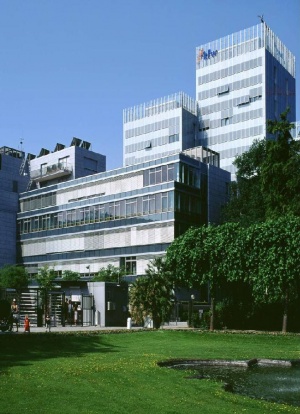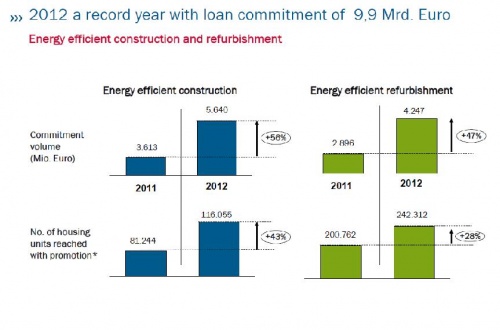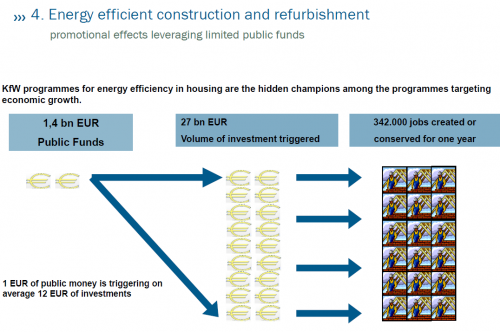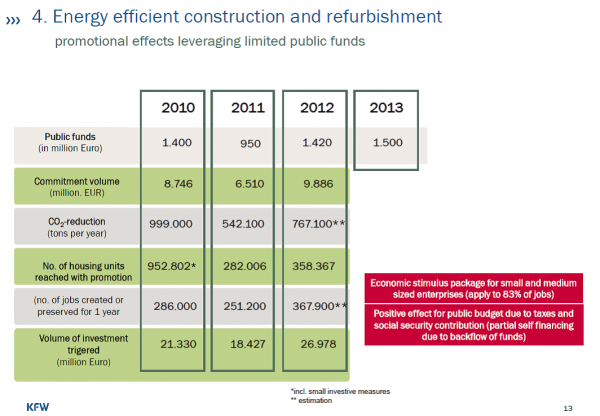Kredietinstelling voor wederopbouw KfW - NL
The Kreditanstalt für Wiederaufbau KfW (Kredietinstelling voor wederopbouw) is een bank die energie efficient bouwen, nieuwbouw en renovatie, financiert. Het subsidieert projecten om CO2 emissies te reduceren en om duurzame brandstoftechnologieën te installeren.
Het Energie-efficiënt Bouwprogramma is er voor iedereen die een energie-efficient huis wil bouwen of kopen. Leningen van € 50,000 per woonunit zijn beschikbaar tegen aantrekkelijke voorwaarden. Hoe beter de energiestandaard, hoe hoger de terugbetaalbonus;
Het Energie-efficiënt Verbouwprogramma is er voor iedereen die investeert in het energie-efficiënter maken van oudere woongebouwen of een recentelijk verbouwd huis gaat kopen. Zowel leningen als schenkingen zijn beschikbaar (waarbij de hoogste standaarden de meeste ondersteuning krijgen)
KfW Duurzame Energieprogramme voor het installeren van Duurzame energieinstallaties.
KFW accepteert de PHPP (Passive House Planning Package) als bewijs voor de energie-efficiëntie van het ontwerp.
Voornaamste cijfers
- Stimuleringsbank van de Federale republiek Duitsland
- In 1948 opgericht als de Kreditanstalt für Wiederaufbau om de wederopbouw na de tweede wereldoorlog te financieren
- Aandeelhouders: 80% De Federale Republiek, 20% de Provincies
- Hoofdkwartier in Frankfurt am Main en kantoren in Berlijn en Bonn
- Representatieve kantoren: ongeveer 70 kantoren en vertegenwoordingingen wereldwijd
- Totaalbalans eind 2010: 441.8 miljard Euro
- Financierings volume 2011: 70.4 miljard Euro
- Ongeveer 4.530 medewerkers (2010)
- De beste rating: AAA/Aaa/AAA
Overzicht
KfW, eigendom van de Duitse staat, is enorm, zegt Damian Carrington (1) blogger voor de “Gardian” . Het heeft een half biljard Euros aan vermogen, wat zo ongeveer twee keer de omvang van de World Bank is. Het heeft in 2011 70 biljoen Euro uitgeleend, die op de internationale markt tegen lage rentetarieven is opgehaald dankzij de AAA credit rating. Ongeveer een derde gaat naar energie en klimaatveranderingsinvesteringen, inclusief 24 biljoen Euro aan energie-efficiëntie in woningen tussen 2009-2011, wat het hefboom is voor een totale investering van 58 biljoen Euro. Wat heeft KfW bereikt. Sinds 2001 hebben de leningen bijgedragen aan het isoleren en kierdicht maken van 2 miljoen woningen, goed voor 200.000 banen per jaar. Sinds 2006 is er 156 miljoen ton Co2 bespaard, gelijk aan een kwart van de totale jaarlijkse emissie van Groot Brittanië.
De sleutel zijn zeer lage rentekosten, op dit moment 1-2%. Deze worden verkregen door de zeer goede kredietwaardering van KfW's, aangevuld met regeringssubsidie voor het rentepercentage. In 2011 heeft de staat bijna €1 biljoen bijgedragen, die door KfW naar €6.5 biljoen in leningen is uitgekeerd, die in totaal tot een investering van €18.5 biljoen hebben geleidt – dat is een hefboom naar het twintigvoudige van de staatssubsidie. "Dit programma houdt zichzelf in stand," voegt dhr. Macioszek, directeur van KfW, toe. "Als de staat €1.5 biljoen inbrengtn [om de rentepercentages te subsidiëren] krijgt het €3-4 biljoen aan inkomstenbelasting over het werk terug. Dit programma is een van de succesvolste dat we hebben." In het KfW programma geldt, hoe hoe de deal. Voor de efficientste huizen – Passiefhuisstandaard - krijg je tot 12.5% van de lening terug. En als je niet wil lenen, kun je een schenking krijgen tot 20% van de kosten van de bouw. Dit telt allemaal op ten behoeve van het brede commitment voor energie-efficiëntie.
Maar waar is dit proces begonnen. Kijkend naar de meer recente tijd, heeft KfW’s in de 1990's de eerste programmas ontwikkeld die specifiek ontworpen waren om klimaatbeleid te ondersteunen.(2) De resulaten waren indrukwekkend. vanaf 2010, heeft KfW de renovatie naar de huidige energie-standaarden van in totaal 9 millioen huiseenheden van voor 1979 gefinancierd.. Tussen 2006 en 2009 hebben KfW programma's 1 miljoen bestaande huizen met energie-efficiënte produkten voorzien, en zijn er ongeveer 400.000 hoog energie-efficiënte nieuwbouwwoningen gebouwd, die direct ongeveer a kwart miljoen banen per jaar heeft gegenereerd, voornamelijk in de bouw- en toeleveranciersketen. De Energie-efficiëntie in nieuwe gebouwen is verdubbeld tussen 2002 - 2009, van een berekend energieverbruik van 120 kWh/(m2a) naar 60 kWh/(m2a), terwijl bij renovatie een reductie naar ongeveer 80 kWh/(m2a) in bestaande gebouwen is gerealiseerd. Geschat wordt dat iedere euro aan subside een hefboor is voor €9 aan leningen en private investeringen, met een hefboomration van 1:10 voor de the KfW programma's en 1:12,5 voor het Markt Stimulerings Programma (MAP). Bovendien heeft het KfW energiebesparingsprogramma tussen 2006-2009 de stookkosten verminderd met 1 biljoen Euro per jaar, wat heeft geresulteerd in een vermindering van de CO2-uitstoot van bij 4 MtCO2/jaar. CO2-besparing door de ondersteuningsprogramma's (lage-rente leningen en investeringssubsidies door KfW en MAP) worden geschat op 1,2 MtCO2 per jaar. VOor de levensduur van de investeringen, worden de langjarige besparingen geschat op ongeveer 72 MtCO2. Volgens de laatste gegevens, is 2012 is record-brekend jaar voor KfW. De verplichtingen bedragen ongeveer 9,9 biljoen Euro, wat een groei van ongeveer 50% in vergelijking met 2011 in zowel de energie-efficënte bouw als renovatie betekent.(3)
Energie Efficiënte Bouw en Renovatie
De hefboomfactor ook hoog vergeleken met de analyse die hierboven is gegegen: iedere publieke euro die is geïnvesteerd heeft 12 euro aan extra inversteringen opgeleverd. Er zijn ook belangrijke sociale voordelen het directe gevolg van de programma's.
Maar wat is in werkelijkheid de inhoud van deze programma's? Welke maatregelen worden gekozen, wie kan er van profiteren, en onder welke voorwaarden?
Energie-efficiëntie en bedrijfsmilieubescherming (4)
Financieringsprogramma's
'KfW Omgevingsbeschermingsprogramma'
Vpor wie
• Duitse en buitenlandse bedrijven, • ZZP-ers • Ondernemingen die onder een energiecontract vallen • Cooperaties en werkgeversmodellen (PPP)
Waarvoor?
Voor investering in en buiten Duitsland die bijdragen aan het duurzaam verbeteren van de milieusituatie. Buiten de EU, zal het van de Duitse partner worden gefinancierd.
Welke stimuleringsfondsen zijn beschikbaar?
• leningen om investering en algemene milieubeschermingsmaatregelen te financieren, normaalgesproken 10 miljoen Euro per project
Wat maakt deze KfW lening zo bijzonder?
• Tot 3 terugbetaalvrije startjaren • 100% terugbetaling • Bijzonder aantrekkelijke rentetarieven voor kleine bedrijven
Aanvraag van de lening: bij je bank
KfW Energie Efficiëntie Programma
Voor wie?
• Duitse en buitenlandse bedrijven, • ZZP-ers • Ondernemingen die onder een energiecontract vallen
Waarvoor?
Voor investeringen in en buiten Duitsland die aanzienlijke energiebespaarpotentie hebben. Buiten de EU, zal het van de Duitse partner worden gefinancierd.
Vervangingsinvesteringen moeten leiden tot een uiteindelijk energieverbruik van ten minste 20% op basis van het gemiddelde gebruik van de voorgaande 3 jaar. Nieuwe investering moeten een energiereductie van ten minste 15% in vergelijking met het gemiddelde in de industrie.
Welke stimuleringsfondsen zijn beschikbaar Leningen om investeringen in energie-efficiënte maatregelen, normaalgesproken 25 miljoen Euro per project. Wat maakt deze KfW lening zo bijzonder?
• Tot 3 terugbetaalvrije startjaren • 100% terugbetaling • Bijzonder aantrekkelijke rentetarieven voor kleine en middelgrote bedrijven
Loan application: with your bank. KfW Energy Turnaround Financing Initiative. For whom? For large commercial enterprises in and outside Germany with an annual group turnover EUR 500 million to EUR 3 billion. For what? For large-scale investment projects in Germany in the areas of energy efficiency, innovative projects in the areas of energy conservation, electricity generation, storage and transmission as well as the use of renewable energies.
What promotional funds are available?
• Direct loans under a banking consortium, with KfW contributing 50% to the financing of the project
• Financing package composed of a loan on-lent through a bank and a syndicated loan with participation by KfW
What makes this KfW loan so special?
• High financing volume
• Disbursement 100%
• Up to 3 repayment-free start-up years
Loan application:
• Direct loan under a bank syndicate: To be filed by the syndicate partner with KfW, no particular form being required
• Financing package:
Application for the on-lent loan: with the applicant's regular bank Application for the syndicated loan: To be filed by the syndicate partner with KfW, no particular form being required
BMU Environmental Innovation Programme For whom? • German and non-German enterprises and other natural persons and legal entities under private law, enterprises in which municipalities are the majority shareholders
• Local and municipal authorities, companies owned and operated by municipal authorities, municipal special-purpose associations
• Other special-purpose associations or institutions incorporated under public law
For what? For the financing of major industrial projects that demonstrate for the first time in what ways advanced technological procedures and combinations of procedures can be put to use to reduce environmental pollution and ecologically sound products can be manufactured and employed.
What promotional funds are available?
Up to 70 % of the financeable costs, no maximum amount. What makes this KfW loan so special?
• Long-term financing at an attractive interest rate
• Interest grant from the BMU to the KfW loan
• In exceptional cases, investment grant of up to 30 % of the financeable costs
• Disbursement 100 %
Loan application: with your bank. Advisory programme. SME Energy Efficiency Advice. For whom? For small and medium-sized enterprises with total annual energy costs of more than EUR 5,000. For what? For initial and/or detailed advice. The advisory services must be provided by an independent energy expert who is accredited for the programme "SME Energy Efficiency Advice".
What promotional funds are available?
• Initial advice: grant of 80% of eligible advisory costs (net fee), up to EUR 1,280.
• Detailed advice: grant of 60% of eligible advisory costs (net fee), up to EUR 4,800. Payments are made directly to your account. Application for the grant: with a regional partner of KfW, e.g. chamber of commerce, chamber of trade, trade promotion society or energy agency in your region. Housing, home modernisation and energy conservation. Energy-efficient Construction. For whom? For everyone who is building or purchasing an energy-efficient home.
What does "energy-efficient" mean?
Energy standards are laid out in the Energy Conservation Ordinance (Energiesparverordnung/EnEV). These standards apply to all new buildings. We finance homes that consume less energy than this ordinance demands. Such energy-efficient homes require innovative heating technology based on renewable energies (such as solar, geothermal, biomass, wood, wind, hydropower) and very good thermal insulation. So they cost more to build than a "normal" new home.
What promotional funds are available?
Loans of EUR 50,000 per housing unit are available at favourable conditions. The better the energy standard, the higher the repayment bonus. Loan application: with your bank. Energy-efficient Refurbishment. For whom? For everyone who is investing to make an older residential building more energy-efficient or purchasing a newly refurbished home Refurbishment into a "KfW Efficiency House" - what does this mean? The energy standards are laid out in the Energy Conservation Ordinance (Energiesparverordnung/EnEV). These standards apply to new buildings. We promote the refurbishment of houses if after refurbishment they do not exceed a specific energy requirement for a comparable new house. KfW has defined five levels of support for a "KfW Efficiency House".
• KfW Efficiency House 55
• KfW Efficiency House 70
• KfW Efficiency House 85
• KfW Efficiency House 100
• KfW Efficiency House 115
• KfW Efficiency House Monument
Simply put, the figures indicate in per cent how much of the maximum primary energy requirement specified by the EnEV the house consumes. The best standard (55) receives the highest support. In order to meet the high energy standard of a KfW Efficiency House, extensive investments such as the renewal of heating systems, thermal insulation and replacement of windows, are usually required.
Individual measures. If the costs and effort of a complete refurbishment would be too high it is also possible to implement only individual measures. Financing is available for
• Thermal insulation of walls, roof and floor space
• Renewal of windows and exterior doors
• Installation/renewal of a ventilation system
• Renewal of the heating system
• Optimisation of heat distribution for existing heating systems
What promotional funds are available? Either a grant or a loan. Grant per housing unit:
• 20.0 % for a KfW Efficiency House 55, not more than EUR 15,000
• 17.5 % for a KfW Efficiency House 70, not more than EUR 13,125
• 15.0 % for a KfW Efficiency House 85, not more than EUR 11,250
• 12.5 % for a KfW Efficiency House 100, not more than EUR 9,375
• 10.0 % for a KfW Efficiency House 115, not more than EUR 7,500
• 10.0 % for a KfW Efficiency House Monument, not more than EUR 7,500
• 7.5 % for the implementation of individual measures, not more than EUR 3,750
The grant is transferred to your account after completion of the refurbishment measures.
Application for grant: with KfW
Loan: up to EUR 75,000 per housing unit for energy-efficient refurbishment plus a repayment bonus calculated on the loan amount.
• 12.5 % for a KfW Efficiency House 55
• 10.0 % for a KfW Efficiency House 70
• 7.5 % for a KfW Efficiency House 85
• 5.0 % for a KfW Efficiency House 100
• 2.5 % for a KfW Efficiency House 115
• 2.5 % for a KfW Efficiency House Monument
The repayment bonus is transferred to your account. This means you have to pay less. Loan: For individual measures up to EUR 50,000 per housing unit Loan application: with your bank Energy-efficient Refurbishment - Construction supervision What promotional loans are available? Grants for professional construction supervision by a technical expert 50 % of the costs for the supervision of construction, maximum of EUR 4,000 Application for the grant: with KfW Age-appropriate Conversion. For whom? For everyone who is remodelling a home to reduce barriers or purchasing a newly converted home.
For what? The programme is good not only for senior citizens. It also benefits persons with limited mobility and families with children. Financing examples include:
• Remodelling to reduce barriers, such as walk-in bathtubs and handles
• The creation of adequate clear space, for example for wheelchair users
What promotional funds are available? For age-appropriate conversion up to EUR 50,000 per housing unit can be financed at favourable interest rates. Loan application: with your bank. KfW Home Ownership Programme. For whom? For everyone who wants to buy or build a house or a home to live in themselves. What are the funds for? Land acquisition and construction costs or purchase price including ancillary costs such as notary public and real estate agent fees, land transfer tax and purchase of cooperative shares to obtain membership of a housing cooperative. What promotional funds are available? Up to EUR 50,000 can be financed with the KfW loan. Funds from this programme may always be applied for additionally to finance the acquisition of owner-occupied housing. Loan application: with your bank.
references:
(2) http://sticerd.lse.ac.uk/dps/case/cp/KfWFullReport.pdf
Practiacal outcomes
First, the German ‘three-pillar’ approach of integrating energy efficiency provisions into a clear framework of regulation, information and support for renewables has served it well, creating a strong, enforceable legal standard to underpin change and generating a clear, consistent message about the direction and required radical nature of change.
Second, KfW provides repayable loans on favourable terms, or performance-linked investment subsidies, rather than unconditional subsidies or tax concessions, as a more reliable and sustainable funding mechanism.
Third, the German schemes provide qualified expert advice and installation so that appropriate work is carried out to a high standard. As a result, the promised energy gains and a positive customer experience have been achieved, and over time the German construction industry has acquired great expertise in this area.
Fourth, German policy requires investments in energy efficiency to be made before subsidies for renewable energy are paid. This increases the proportionate contribution renewable energy can make to meeting overall demand, saves money, makes a bigger contribution to the wider goal of climate protection, and provides a more coherent overall message to the public about the need to reduce CO2 emissions.
Fifth, German policy assumes it is better to adopt a ‘whole house approach’ to energy saving, even if measures are adopted piecemeal, and high energy efficiency measures only implemented bit by bit as people work on different parts of their houses. This enables the overall ambition for energy efficiency improvement to become clear for energy suppliers and builders, while giving some assurance to government that the required emission reductions will be achieved. Sixth, policy aims to support experimentation and innovation, to build awareness and familiarity for new approaches to energy efficiency, and to identify successful approaches that can be taken to scale. Seventh, public buildings have an important role to play, to provide conspicuous examples to the public of what can be achieved by ambitious retrofit measures. This is particularly the case in schools, nurseries and children’s centres, where such measures can have important educational benefits as well. Ultimately, conserving attitudes and behaviour towards energy use, and awareness of the need to reduce greenhouse gas emissions, are going to be required if the necessary step changes in home energy efficiency are to be achieved. There has so far been widespread public support in Germany of the government’s energy saving and green initiatives. This is at least partly because of a perception in Germany that energy saving and climate policy can create energy security and economic benefits for the future. (5)
reference
(5) http://sticerd.lse.ac.uk/dps/case/cp/KfWFullReport.pdf
KfW project in Aspiring region Latvia
Meer informatie:
Energieeffizient bauen und sanieren mit der KfW zu besten Konditionen



